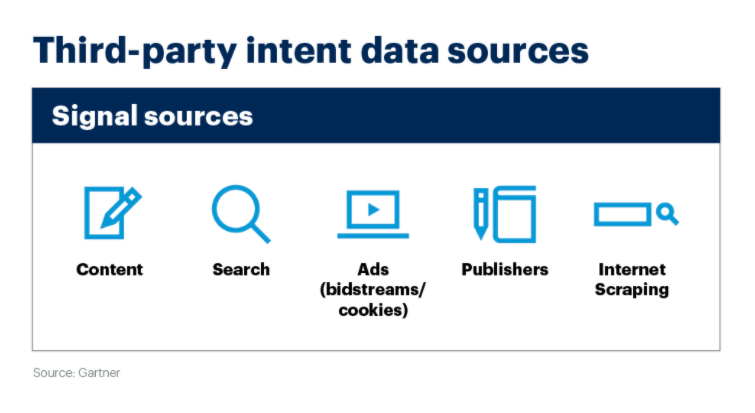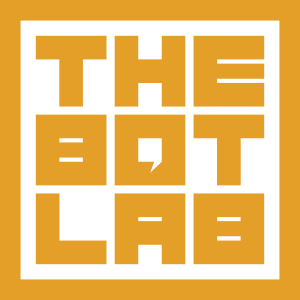By Eliav Cohen and Lindsay Angelo
Marketing teams and demand generation professionals have one goal with B2B intent data. Get the sales team connected with in-market prospects who are currently researching and in an active buying journey. That’s it. These B2B prospects are the easiest and fastest to move down the marketing funnel and convert into customers. Although there are multiple challenges turning content consumption and B2B intent data into actionable million-dollar opportunities, the main challenge with intent data is that it is hard for B2B sales teams to actually get in contact with prospects.
This is where companies that align their B2B sales team and marketing team get a competitive edge to achieve their business goals. Marketing automation technology like account-based marketing (ABM) is helpful. Without these marketing automation systems, salespeople get jaundiced with intent data due to the constant rejection when reaching out to prospects that are “supposedly” hand-raisers.
Another B2B marketing challenge with intent data is that most competitors get the same intent data. It’s a race to get to the prospect and although the potential customer might be researching, they aren’t lead yet. The truth is the prospect has no information about your company or what you offer prior to a salesperson sending out personalized email cadences, videos, or calling a prospect on the phone.
Enterprise marketing is challenging. Especially incorporating intent data into enterprise B2B marketing and sales processes. In a recent study of CMOs, “67% of marketers find intent data hard to action”. There has to be a better way to shorten the sales cycle through actionable insights and behavioral signals. The next generation of buyer intent data allows sales teams to easily convert qualified active buyers with high intent. All that’s needed is instant access for potential customers to get their questions answered.

What does that look like? Actionable B2B intent data at the actual moment and location the intent occurs. Before we chat about in-moment instant access connections with potential customers, we’ll run through the different types of intent data and how they are currently used in the sales process. We aren’t going to go into the details of firmographic customer data, psychographic customer data, or technographic customer data. Instead, we are going to go back to the basics. That’s always where the largest lifts in conversion occur.
1st Party vs 3rd Party Intent Data: What’s The Difference?
First-party data: Every time you collect data about your users on your own website, that’s first-party intent. For example: Collecting information about visitors through google analytics, chatbots, and cookies. The CRM records the information from visitors who take certain actions on your website; it can include things like what pages were viewed, how many times they’ve visited, what they downloaded, or qualifying information to score the prospect as a “good” lead. Prospects that have taken the most actions on your website are most likely the hottest leads your salespeople should be talking to.
Sources of first-party intent data:
Google Analytics – Google Analytics provides a ton of general first-party intent data from online activities. How many times a page was viewed, location of views, time spent on a page and visit duration. Recent and contextual activity matters. This data is mostly been used by marketers to track content performance and see what pages people spend the most amount of time on so they can determine which pieces should be created next for their audience.
IP address lookup services with firmographic data – Companies like Clearbit do a great job at discovering account-level data about the prospect. What is account-level data or account-level information? Account-level data is the name of the company and its public firmographic information. This firmographic data provides valuable insights in making sure that the inbound lead is a good fit to be a potential client. Types of firmographic data include the number of employees, revenue numbers, what state their headquarters is in, and 80+ data points. These data points help sales operations teams route prospects to the right salesperson and score the likelihood of the prospect being able to purchase.
Chatbots – Chatbots are the highest level of high intent first-party data as they are interactive calls to action. Prospects that interact with chatbots are taking direct action to interact with the company. They may have a question about a product or service or may be interested in booking a demo. The information collected in the chatbots gets mapped to the CRM system and can be used to immediately qualify a prospect. Qualifying prospects or scoring prospects quickly leads to a competitive advantage to massive revenue acceleration.
All this first-party data gets shoved into a CRM where sales operations folks sift through the data and tell salespeople who they should be in contact with in order to help salespeople exceed their quota. That’s the goal anyway right? Grow sales numbers.
Third-Party Intent Data
Third-party data is a little different and much harder to take action with. The goal is to Catch Qualified Leads In The “Research Phase”. Although it sounds simple, it’s not as easy as it seems to recognize buying intent and get into a conversation with the prospect.
Third-party intent data comes from a ton of different sources: The main sources of intent data come from review sites, content interactions (downloading a resource), Niche content sites around a specific industry, active email lists that send personalized content to specific persons, and of course cookies and search terms.

This data is a gold mine. Buyer data or otherwise known as B2b buyer intent data utilized properly can lead to a very effective sales and marketing team. You can use ZoomInfo (both first- and third party), Leadfeeder Bombora to identify when prospects begin their journey towards your products or services, what exactly they’re looking for at each step in that process. These services have buyer intent algorithms and combine intent data to help companies have the best chance when cold calling.
You know that feeling when you spend an entire workweek planning your vacation? Well, buyers will often do the same thing before they purchase something. The research phase is where buyers engage with multiple reps and consult their colleagues for advice on what to buy – even if it’s just lunchtime chat! And one way this takes place online are through third-party review sites. There are 10+ core business review sites to compare software, including some companies that will charge to do the competitor research for you. These companies like G2, Software Advice, Capterra, etc, offer brands intent data by providing the lists of companies that are looking for a product in their category or reading reviews about their company. There is no better intent data than this moment of actively reading a review. This data gets shoved into a black box through an API, and causes sales operations folks tell sales reps that these are leads are hot. At least the salesperson knows they are in the research phase. It still doesn’t solve the challenge of getting into a conversation as the rep is reaching out 24 hours to 3 weeks post research. You have to catch them in the moment of research for the highest conversion opportunity.
Wouldn’t it be an amazing experience for a prospect to be reading a review or an article on a company and be able to instantly chat with a salesperson? 71% of prospects aren’t ready to commit to a demo, but are willing to give their email to get a quick question answered. Once an interaction is taking place, it is up to the salesperson to use transactional sales training and move the prospect to a demo as quickly as possible.
That’s what the helium platform does. Helium allows brands to answer questions, jump on instant zoom meetings, and book demos from third-party sites. These are high intent niche sites where prospects are researching, learning, and digesting content. If the content is good, the prospect is in market, and has a question, you can bet they’ll want to chat.

Most likely you already have a chatbot or conversational commerce on your website. Most B2B companies use Drift, Qualified, or some other Ai chatbot platform (conversational commerce). It’s incredible for converting and qualifying prospects that need a question answered before booking a meeting. The question is why we are forcing prospects to jump to another website to chat or book a demo. The good news is you don’t have to anymore. Now you can expand your funnel with highly qualified leads and connect with prospects during the earliest active B2B buying stage.
We went through a ton of terms in this blog post. We’ve listed some additional questions you may have:
Where does B2B intent data come from?
To better understand businesses purchasing intent, platforms have been building predictive layers from billions of behavior signals taken from thousands of online locations. This is called your digital footprint. The data could be collected from a search term you used, a specific website you visited, or a form you filled out with your company or personal information. B2B companies then purchase this data to predict interests in particular products, interests, and challenges.
Is all B2B intent data useful?
Intent data is just data. It isn’t a lead. The vast majority of the signals openly available on the web are actually of no immediate use at all. Signals that come from contextual niche sites such as review sites or journals are more valuable. The challenge is that most intent data is account-level data and not contact-level data. Your enterprise marketing team will know the name of the company but won’t know who the buyer is. Assuming you can get the contact level data, then your team still has to somehow get in touch with the potential customers. That’s where Helium instant access can be utilized allowing prospects to jump down the funnel.
Calculating ROI of B2B intent data signals?
B2b intent data is challenging to calculate as they aren’t leads. Trackable and actionable intent data is easy to calculate as they are conversational qualified leads.
What are the benefits of B2B intent data?
For example, the insight intent data provides can help us understand exactly where an account is in their buying journey, based on the content and keywords they’re researching.
What is B2B buyer intent data?
As B2B marketers increasingly struggle to reach and resonate with the right audiences in a sea of competitive noise, B2B intent data – data that identifies exactly when someone is in-market, or considering a particular solution – provides an accurate effective solution.
What is the value B2b intent data?
In short, B2B buyer intent data allows you to identify exactly if and when a B2B prospect is actively considering, or looking to purchase your product or solution, enabling informed, timely campaign decisions.
What are the Data Platforms and Services?
There are a number of intent data platforms and services available today that can help B2B marketers understand, access, and make intent actionable.
What is intelligent intent?
Intelligent intent platforms work by monitoring and storing such signals from across the web, ad networks and social media, to build predictive layers from billions of behavior signals taken from thousands of locations.
What is the Zero Moment of Truth?
This moment is known as the ‘Zero Moment of Truth’ (ZMoT), and is the most relevant, resonant time to engage and take action.
What is intent data?
With the real-time insight that intent data provides, marketers and sales teams gain the ability to do just that, enabling campaigns with the context, timing and relevance needed to resonate effectively.
What is buyer intent?
As only a small fraction of any potential market is in an active buying journey at any one time – particularly for high investment products, such as B2B technology solutions – without buyer intent insight, it can be hard to maximize the value of sales and marketing activity.
